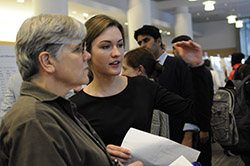
At a poster session on November 21, second-year medical students shared the results of their research projects for the Area of Scholarly Concentration, a four-year longitudinal project that culminates with a thesis at the end of their fourth year. Projects spanned departments: from the basic sciences to clinical investigation, including translational medicine, medical humanities and more.
Effects of Vitamin D on Lung Inflammation in Asthma
Shanthi Narla, second-year medical student, studied the effects of vitamin D on inflammation pathways of cells in the respiratory tract. She found that vitamin D inhibited several signaling proteins and may decrease the inflammatory response in bronchial epithelial cells.
“During the musculoskeletal unit we learned about how vitamin D has an effect on organ systems, and not only on bone health. This lecture got me interested in learning more about the vitamin’s clinical implications,” Narla said.
Narla worked with Tetsuya Homma, PhD, visiting scholar in Medicine-Allergy-Immunology, and in the lab of Robert P. Schleimer, PhD, chief of Medicine-Allergy-Immunology. Further studies may provide a better understanding of vitamin D in airway disorders and the findings may identify ways to enhance the epithelial immune response.
Early Detection of Dementia Through Structural MRI
Accurate diagnosis of cognitive impairment remains a challenge, because the pathologies of these diseases can look very similar: Veronika Hanko, a second-year medical student, examined the hippocampus of post-mortem patients to identify subtle changes in brain shapes.
“The hippocampus is responsible for the transfer of memory storage and is one of the first structures to go in dementia,” she said. “A decrease in volume in the hippocampus can be detected before the disease presents itself, but we are looking at the shape measurements instead of volume to observe changes.”
Working in the lab of Lei Wang, PhD, assistant professor in Psychiatry and Behavioral Sciences and Radiology, Hanko used structural MRI and automated image processing to generate accurate segmentations of the hippocampus, to compare changes in shape to pathology, in the hope of developing better biomarkers for early stages of dementia.

Disparities in Access to Organ Transplantation
Inspired by her immigrant parents, Ania Bilski, a second-year medical student, decided to investigate disparities in access to organ transplantation. She reviewed charts to determine how variables such as English language proficiency impacted a patients wait time from evaluation date to date the patient is waitlisted for an organ. Bilski found a discrepancy of one month between initial evaluation and wait listing for non-American, non-English speakers, compared to American-born, English speakers.
“The next step is to develop a way to monitor who may need more help and having extra resources so non-English speakers can get better access,” Bilski said.
She worked under the mentorship of Michael Ison, MD, associate professor in Medicine-Infectious Diseases and Surgery-Organ Transplantation.
Markers in Idiopathic Pulmonary Fibrosis and Myelofibrosis
Krista Wager, a second-year medical student, looked at bio-markers in the disease pathways of Idiopathic Pulmonary Fibrosis, a disease that involves scarring to the lungs, and Myelofibrosis, a disorder where bone marrow is replaced by scar tissue. By using mouse models, Wager could observe the similarities between both diseases; preliminary results demonstrated an increase in one of the markers, CXCL12, in mice.
This project is a part of a larger project using angiotensin-converting-enzyme (ACE) inhibitor, a drug used for the treatment of high blood pressure, in myelofibrosis with the goal to stop disease progression.
Wager worked in the lab of Seth Corey, MD, MPH, professor in Pediatrics-Hematology, Oncology and Stem Cell Transplantation and Cell and Molecular Biology. She said, “The Area of Scholarly Concentration is helpful to our medical education because we learn the how the discoveries we will use in clinical practice came to be.”






